Combat Performance: It Killed Stuff Pretty damn well.
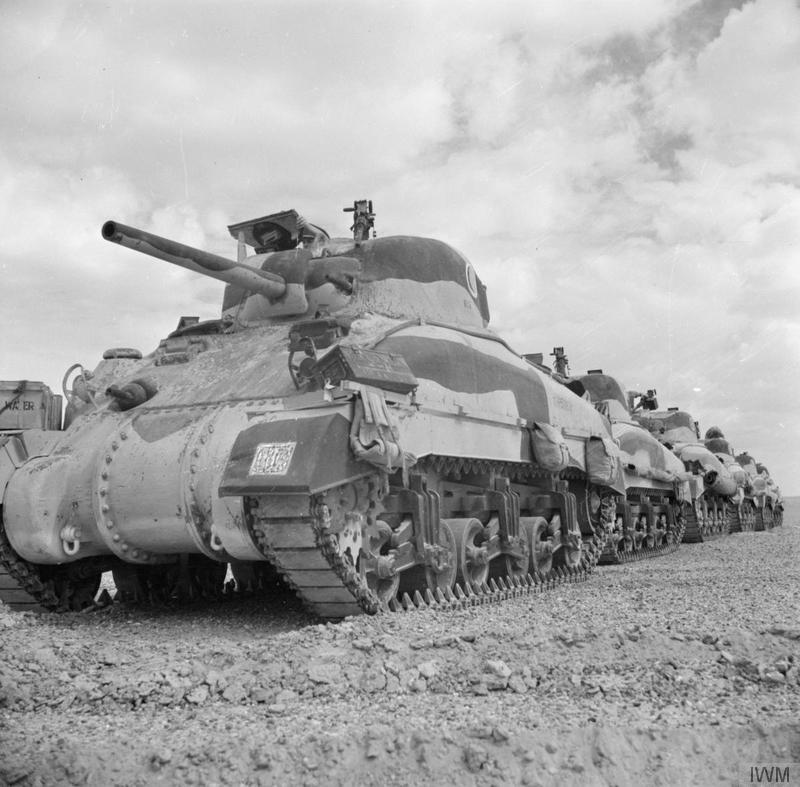
When Sherman went into combat in British hands in the North African desert in October of 1942, it was bar none, the best tank in the world. It had a better gun and more armor, along with good or better mobility than all the axis tanks it faced. It wouldn’t have a German peer until the Panzer IV was up-gunned and even then, the best version of the Panzer IV was barely a match for a 75mm armed Sherman and totally outclassed by the later 76mm armed tanks. The Sherman tank was designed, and the design improved to maximize how easy it was to produce, while also improving the reliability, crew fighting efficiency, safety, and comfort. This was fairly unique to U.S. Tank design and can be attributed in many ways to the automotive production experts who came out of Detroit and the US Auto industry.
The basic small hatch Sherman was found to be fine for the job all the way through the invasion of Italy and Normandy. The introduction of the Tiger and Panther as specialized tanks that were rarely seen. In the Tigers case, they were right. It was a rare and more or less useless waste of German resources. The Panther would become much more common after the break out from Normandy, but if you really look at its performance, it was not that great of a threat. In most cases when they met in Europe, the Sherman won. The 75mm M3 Armed Sherman was very well equipped to deal with infantry and AT guns, the main threat they would face, and this was part of why the US Army didn’t want to jump to the available at the time of Normandy, 76mm armed Shermans.
The US Army tried the M1 gun out on the Sherman just about when the Sherman 75 hit production. The Sherman Minutia Site has images and covers the history, as do various books, the M1 gun fit, but was a tad long, so they just chopped off more than a foot from the barrel. It worked well enough they ordered 1000 Shermans armed with the gun, but then the order was canceled because the turret was too cramped. Later, they would adapt the T23s turret to the Sherman hull for a much better solution to the problem of up gunning the tank. After the war, the many 75mm Shermans were up-gunned with the M1A2 gun and then given to allies as military aid. A fun way to see a few of these tanks in action is to watch the 70s movie, Kelly’s Heroes, the Shermans in that are all up-gunned 75mm turreted M4A3 tanks.
The Sherman, even the version armed with the 75mm gun, could still deal with the heavier Nazi German tanks, as long as it had room to move around, and knew where it was. Much noise has been made about how it was a death trap after the D-Day landings and the Panther and Tiger tore it up in the bocage. This is a myth. There is pretty good evidence the US Army only faced maybe two or three Tiger I tanks, in Europe, ever. The Panther was more common, but also got roughly handled in just about every battle it faced Shermans in.
The German’s rarely used the Panther in the bocage country because its long gun made it hard to use in the tight quarters and reliability problems were ever-present with this tank. The tank the Sherman faced in US hands was the Panzer IV and various Stug assault guns, neither of which outclassed the Sherman in any real way. But they did have the advantage of being on the defense.
Post-war studies by the US Army showed the Sherman was more effective than German armor at this point. The claims of the Sherman being a death trap were false. Even early Sherman tanks were no more likely to burn than any other tank and the later war wet ammo rack tanks were the safest tanks of the war. German tanks used gasoline and gas was not found to be a major cause of fires in destroyed Shermans, ammo fires were. See the links in the data section for info on this. Most Sherman losses were due to anti-tank guns, infantry AT weapons and mines, and not so much tank on tank action.
When Operation Cobra was kicked off, the first use of a large hatch hull, wet ammo rack, 76mm armed Shermans took place. The M4A1 76 being the model used first followed by A3 76 tanks within weeks. These tanks were not well received across the board, with some units preferring the 75mm armed tanks because facing armor was rare even then and the 75mm gun was better at taking out anti-tank guns and infantry, and could still deal with any German armor they encountered. Some units welcomed the better anti-tank capability even if it wouldn’t kill a Panther from the front unless at very short range.
By the battle of the bulge, the M4A3E8 and M4A3E2 Jumbo were showing up for combat use. The Jumbo had much thicker armor and were loved by their crews. By the close of the Bulge, German armor would become very rare, but even so more and more 76mm armed Shermans would be issued. By the end of the war, the ratio would be near 50%. The Army also wanted to stop production on the 75mm gunned M4s in 1945, but the USMC and the British still had requirements for the 75mm gun tanks so it stayed in limited production.
There was a bit of a scandal about the Sherman being no good in the press back in the States about the time of the Bulge. The reality was, the Sherman was having its shining moment during that battle and performed very well against German armor that was supposedly better. Bad movies aside, the Sherman more than held its own in the Battle of the Bulge, also known as the Ardennes Offensive. This is covered in Steven Zaloga’s Armored Thunderbolt, in much more detail.
By the time the next generation replacement showed up, the M26, the war was all but over, and only a handful would see combat. In many ways, the M26 was inferior to the M4. Due to its slightly shortened development and testing time, it had a few reliability problems. It was still so reliable that it would have put any German tank to shame though. The motor, though stressed more in the M26, was the GAA, and it was solid and reliable. The very early tanks had some transmission issues, that were resolved, and some minor things like bracing the final drive housings and changing the drive sprocket configuration were the only major changes. It was never as reliable as the Sherman, but it was close enough to be adopted for use by the Army and Marines.
♦♦♦♦
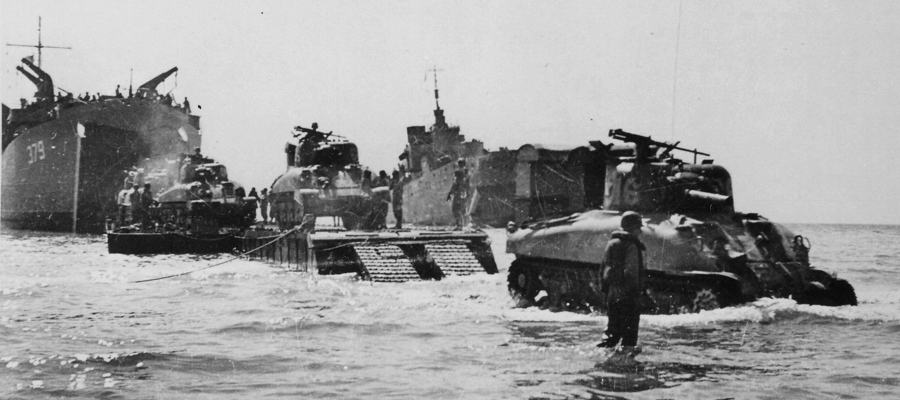

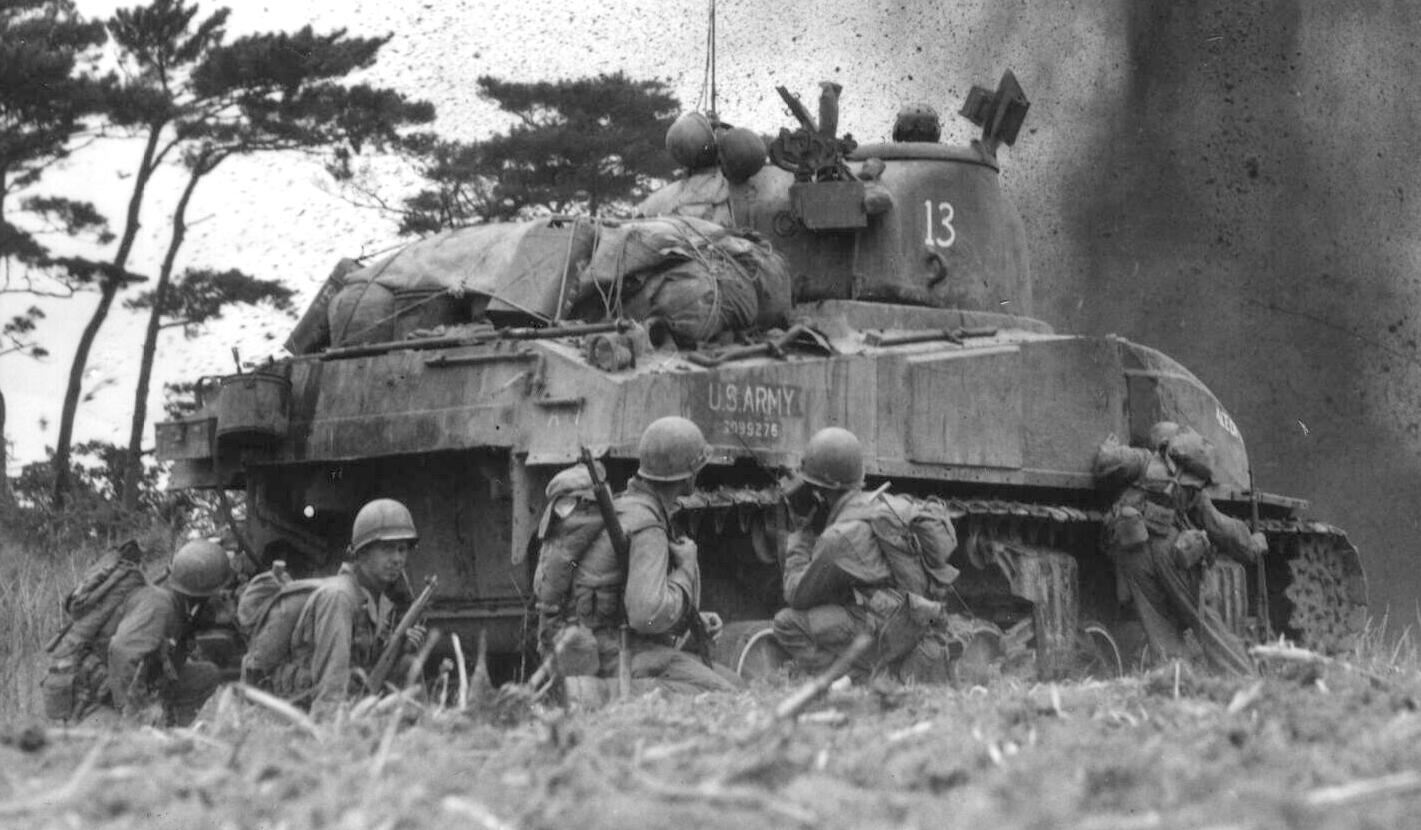
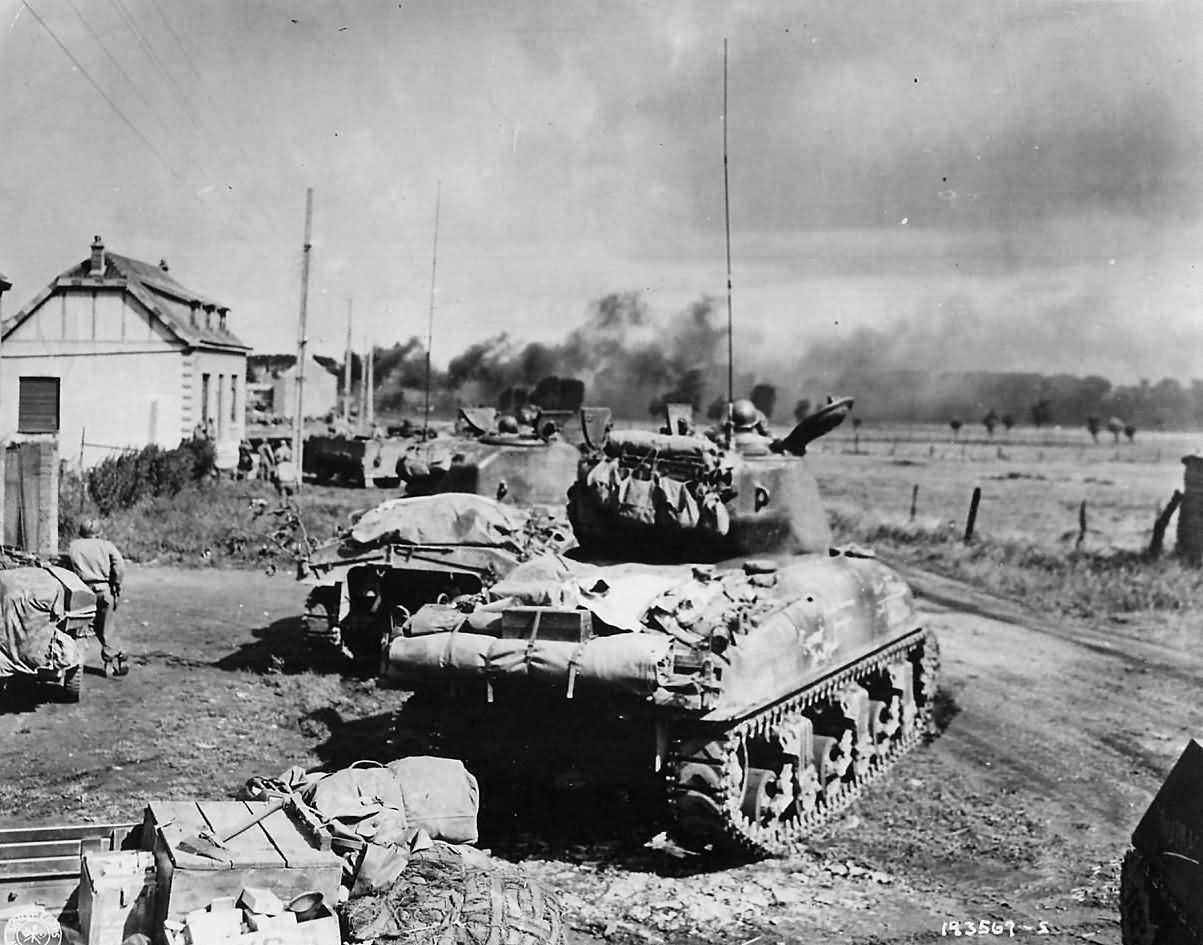
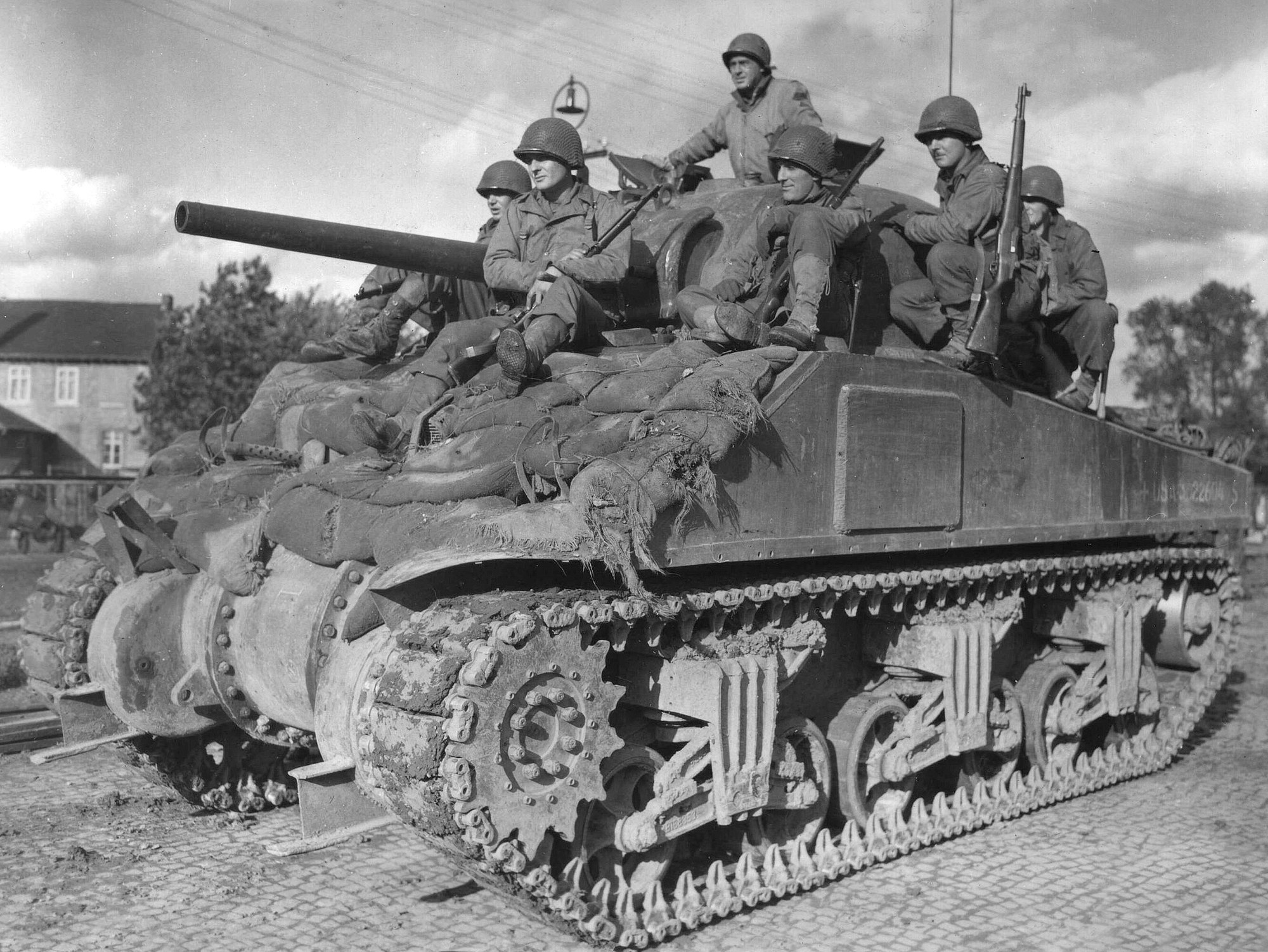
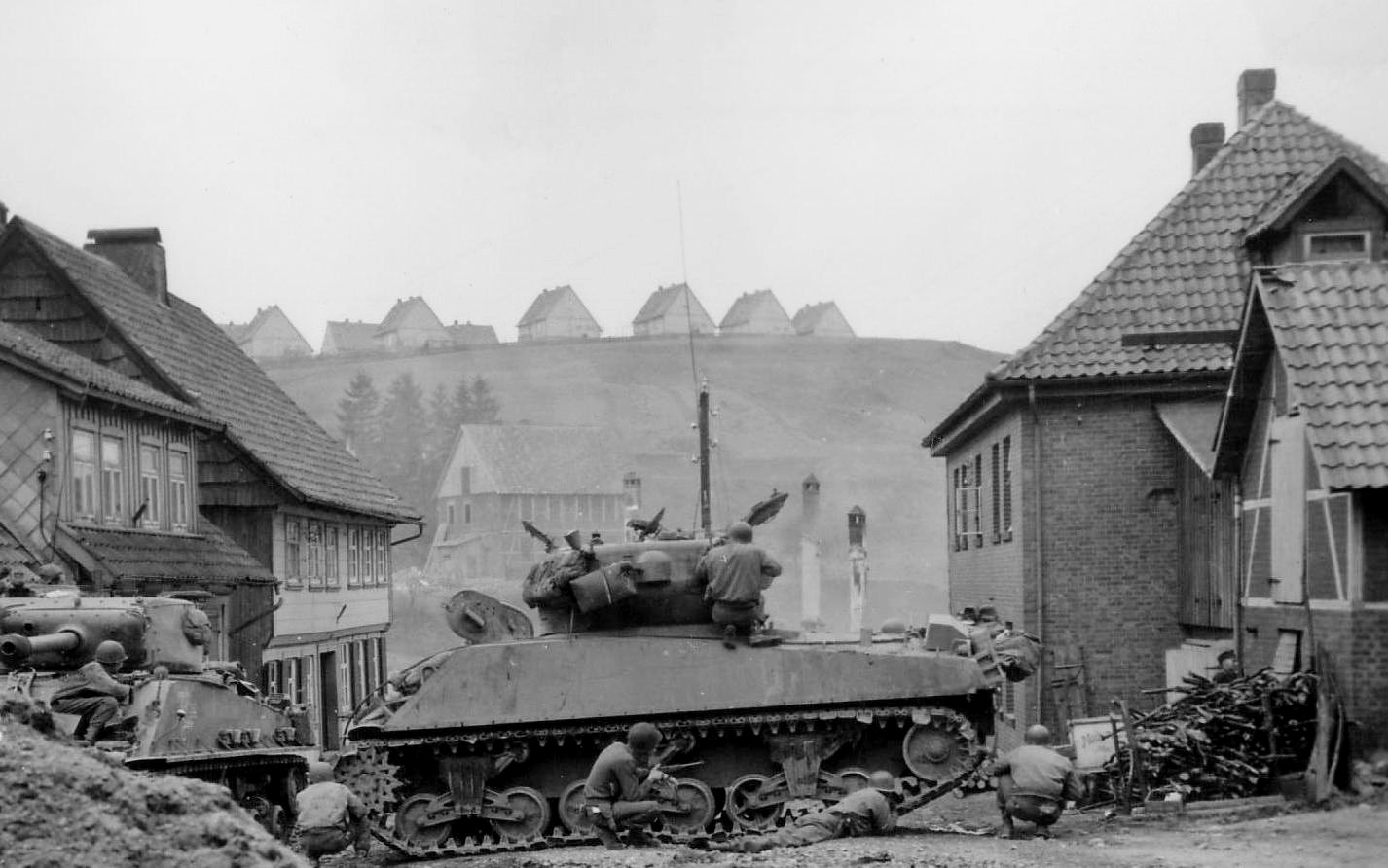
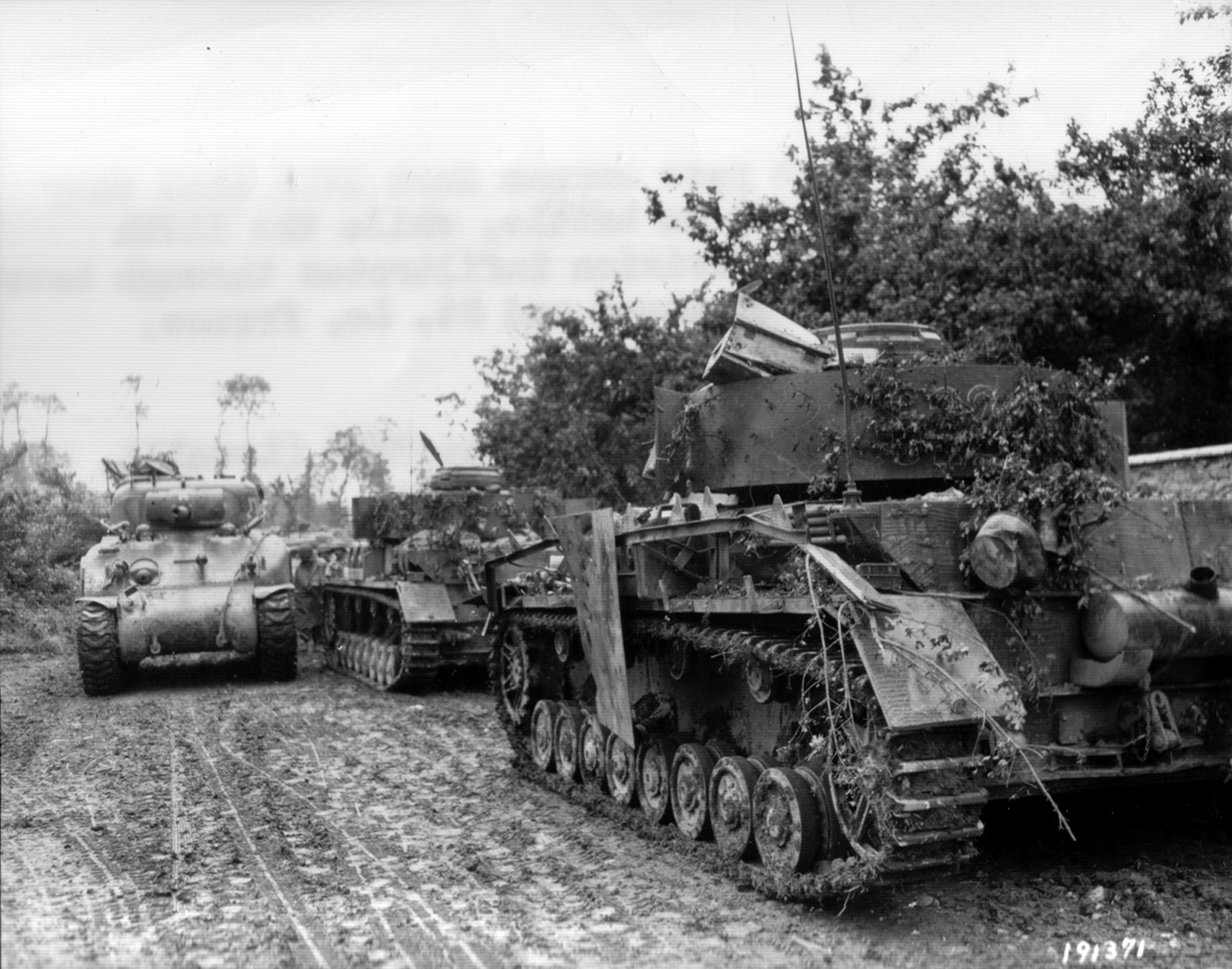
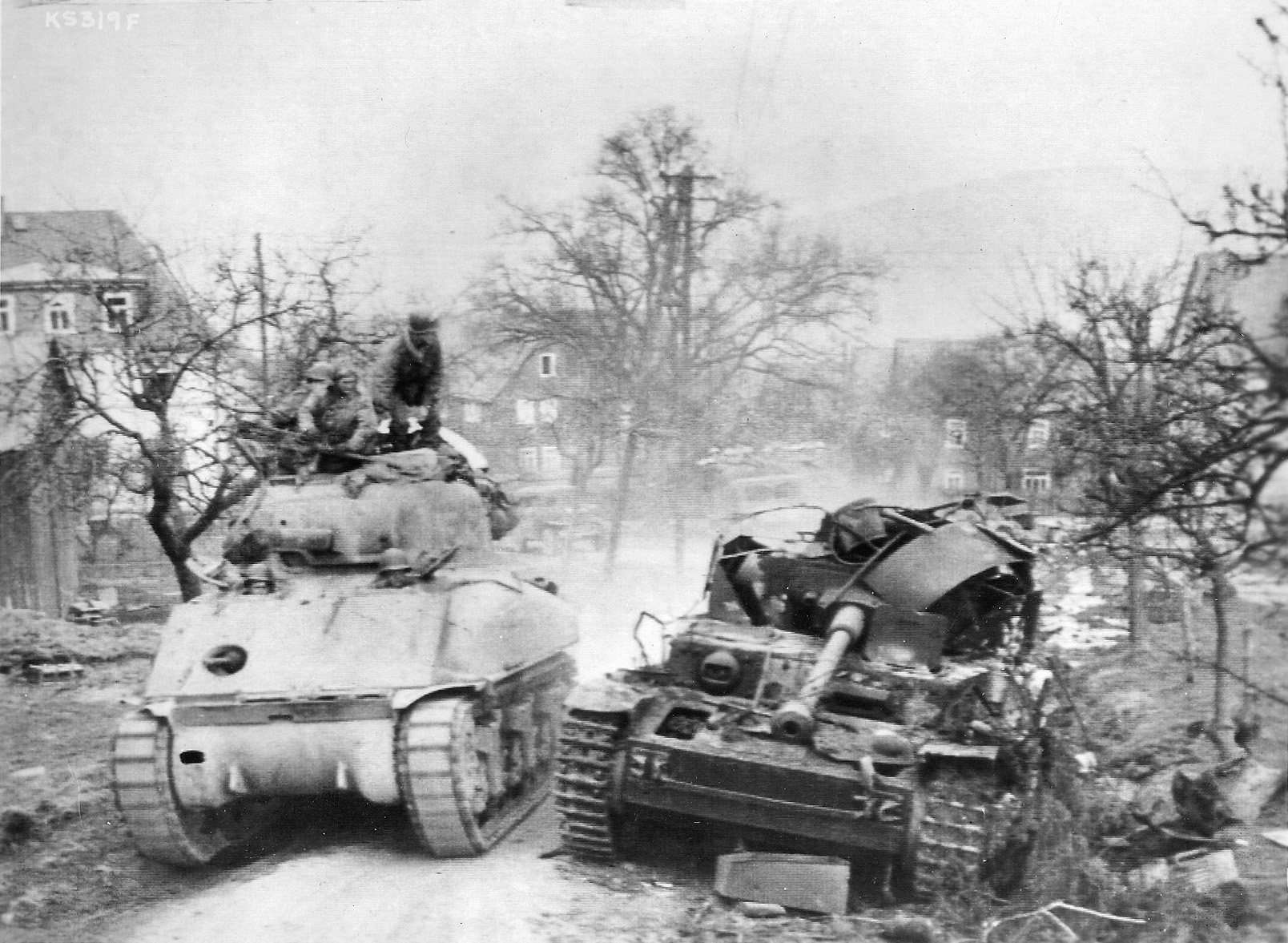
♦♦♦
Sources: Armored Thunderbolt by Zaloga, Yeide’s TD and two separate tank battalion books, Sherman by Hunnicutt, Combat Lessons, The Rank and file, what they do and how they are doing it 1-7, and 9. Archive Awareness, Oscar Gilbert’s, Marine Tank Battles in the Pacific, WWII Armor, Ballistics and Gunnery by Bird and Livingston, M4 Sherman tank at war by Green, the Lone Sentry, the data in the data section
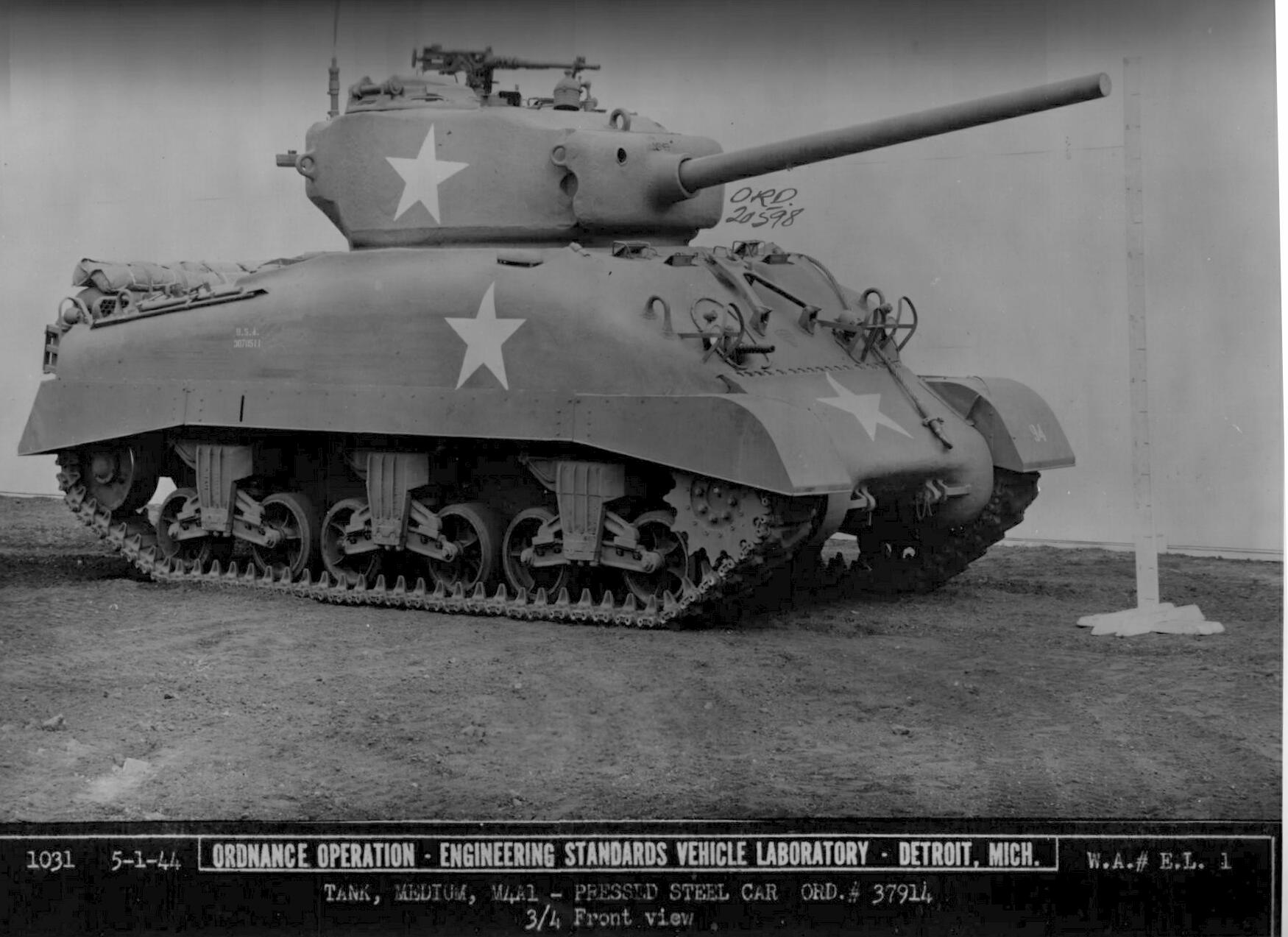
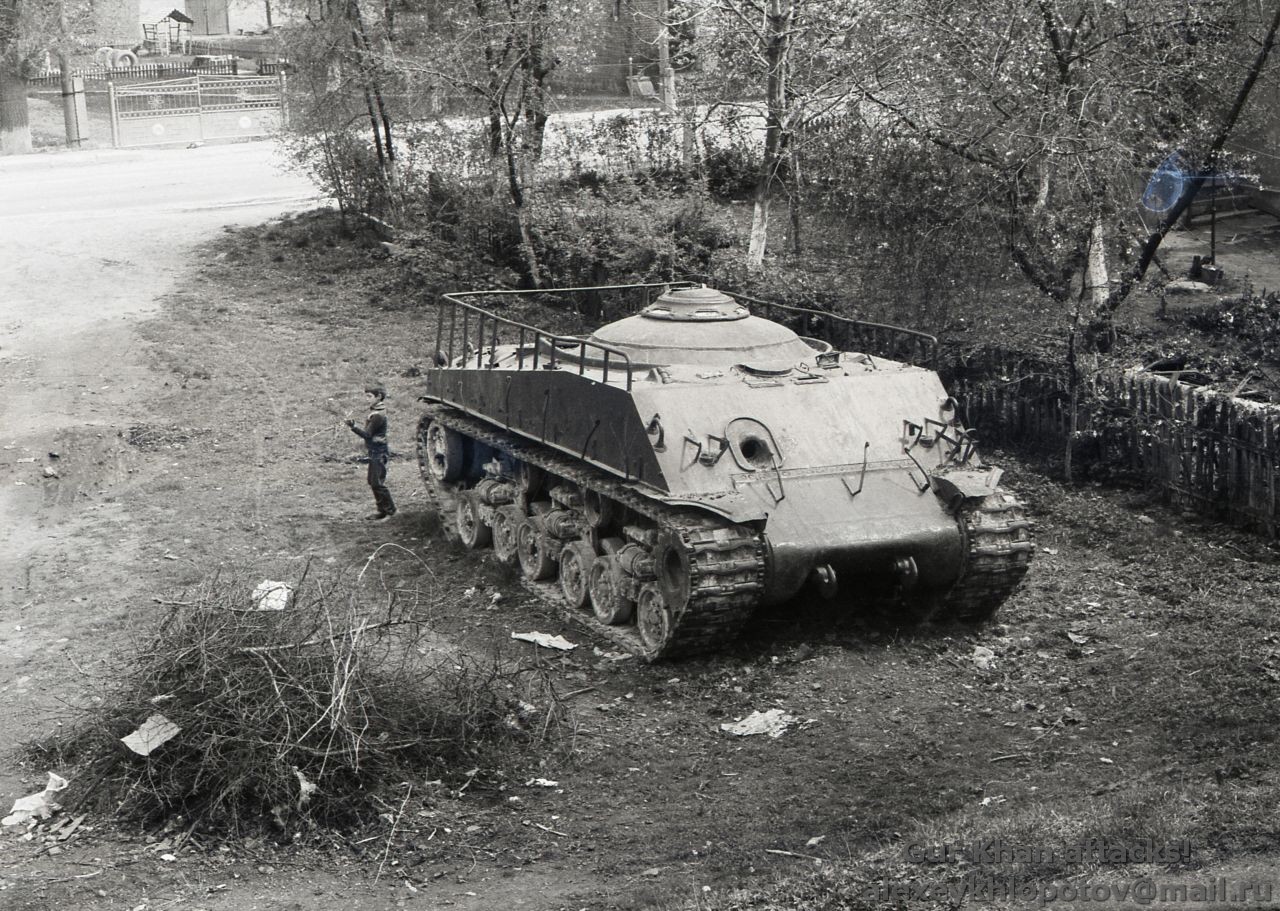
Although you are focused on the individual killing power of the Sherman, it is worth it to note (as you do do elsewhere) that the Sherman seldom acted alone.
Even in the constricted terrain of Normandy, where the Germans had plenty of time to set up ideal ambush sites to play on the strengths of their armour, a Sherman commander had options. While a one-on-one approach to a well-sited big cat would be problematic, most of the time the Sherman would be operating as part of the Combat Command of an Armoured Division, with plenty of infantry on hand. And then that poor big cat is reduced to the status of a static pillbox.
With an overwhelming advantage of divisional and corps-level artillery support, a combined arms assault leaves the German tank commander with nothing but to get out, and trust that his final drive will hold out for the duration of the retreat (hint: it often didn’t).
Mart,
Good points, and sometimes for reasons that go unexplained more often than not, commanders on the scene did not use those Divisional and Corps level assets, or even battalion level assets to help keep tank losses down. We did run short of Arty rounds a few times for sure…
Well, normal human averages also applied to the US Army, so for sure they would have had their share of not-so-competent tank commanders.
In general though, the platoon commanders were smart enough to not operate without supporting arms nearby. The Battle for Normandy was not won by magic weapons like the bocage-buster tank, but quite frankly by the greenish US Army picking up tactical experience.
And here the survivability of the Sherman shines 🙂
not being american or even from a beligerant country on the ww2, just want to tell!
On my opinion for a mediun tank the dherman was a greath tank, even if on a one to one fight betwen tanks and most specialy with tiger ones he are clearly outclassed, but comparing one heavy tank with a mediun tank it is the same of to compare a fight betwen a mastif and a german shepard, where the more lighter can win yes but not frequently if not on biguer numbers, aniway the sherman was supported by a whole mass production sistem on a intact war industrial production and with a massive air support.
I am not traying to make the sherman a inferiour tank, it was realy good but a tank must be compared with others of his category like the PZ4.
Can win against panters often yes but that will depend of the condicions where both are engaged, in short distance a sherman wins, in long one the advantage goes to the panter, and against a tiger well! Most of the times a single tiger will win against a sherman if they have engaged often, wat have not hapened, aniway the main pourpouse of the sherman was to be a multy pourpouse and support tank wille a heavy panzer was maded to breack the lines specificaly,for his pourpouse yes the sherman was unbeatable
p.s- sorry for my english who are not even my second language.
The Sherman had one characteristic that virtually no other WW II tank had and that was reliability. The Russian T34 had horrible reliability and it was described that if you needed 100 T34s to move 100 miles and attack you better send at least 200 tanks. It also leaked like a sieve and the ammunition would get so wet that it would not fire. None of the German tanks were reliable and they were also always slow. Also, if you needed to repair a German tank the parts typically needed to be modified in the field to make it work.
So all in all the best tank of WW II was clearly the Sherman and especially the Easy 8 Sherman.
Huh? none of the German tanks were reliable? Pretty vague statement there
And no the Sherman wasn’t reliable. All tanks had there issues especially in the beginning. The difference with the Sherman was simply that mechanical failures could be fixed very quickly without having to log the failure and pull the tank out of service for the repair.
Speculation by Jentz is not factual info. Depending on the model, the Sherman was actually pretty reliable, meaning the time between major failures, like a motor or Transmission, was good 250 to 300 plus hours, and had German tanks beat hands down. The only tanks even close were the PIV and III.
Poorly designed tanks like the Panther would only benefit so much from abundant spare parts since the repairs themselves were horribly time-consuming.
It may be worth recalling Allied air superiority in most (if not all) the theatres where the Sherman operated. Regardless which tank was better, and to me the Sherman seems a quite balanced medium tank, these would not fight in isolation.
Close air support was often not the deciding factor. It couldn’t reliably kill tanks, especially when compared to anti tank guns. If anything those contributed more to the successes of the ground troops than air support
Losses to air attacks were incredibly small. More tanks were lost to infantry held weapons like the Panzerfaust or Panzerschreck than air attacks. Where air superiority was effective against the German armour was that it seriously disrupted the supply of parts and fuel to the front and significantly hampered the production of tanks by bombing factories.
The Sherman was a piece of shit. Undergunned, underarmoured and had a high profile. So poor was the gun, the Brits changed it for a 17pdr gun to give them a fighting chance against German tanks.
This site is packed with information, statistics and accounts to discount and disprove all of those statements. Even a cursory knowledge of the fundamentals of tank design would do that.
You gotta source for that, Adolf? Didn’t think so.
The Sherman had its flaws but it was not a “piece of shit”.
In war as in racing it is the man more than the machine that matters.
And the Sherman’s performance was close enough to make the man the deciding factor.
John
vanjasper:
can you come up with any reliable sources for that other than game sites and German authored histories, Also, can you also explain why total US Army losses for tankers from 6/44 to 5/45 amounted to 1800 men total? And, that when total kill ratios are worked out between shermans and panthers the ratios come out to 1.3 to 1 in the shermans favor. In short, the shermans killed more panthers than vice versa? Also, can you explain why in every recorded tank battle in US and German archives between panthers and shermans, the winner was invariably the tank that shot first?
Randall, have you ever held the eastern front into consideration? Basically, the americans and their shermans were struggling against someone holding back the entire soviet union.
Jacob
Are you sure you understand the meaning of the word struggling?
The problem with a lot of the Tank on Tank scenarios is that they usually end up being a Sherman Tank vs a Panther on an open field facing each other at 2000 yards. Yes the Panther would win. A realistic scenario would be the two tanks finding each other at 850 yards in broken woods and fields with buildings and other items for cover. Then it comes down to who shoots first. And with the Sherman’s superior sighting systems, not the gunners scope, the Sherman was more likely to see the Panther first.
Going back to what was said earlier, The premise that the Germans were killing 5 shermans to each panther/tiger is a myth. The fighting in western Europe lasted less than a year with the Americans ready to roll into Berlin and halted by SHAPE. It doesn’t matter how many forces the Germans had in the field, the numbers of kills still tell the story. The Germans still lost more tanks than the Americans on one on one fights.
Would like to see your sources, as all of the reliable sources, not to mention actual casualty lists and German sources as well, totally disagree with you.
If you watch the Youtube video “Myths of American Armor. TankFest Northwest 2015” you will see that you are not only very wrong in your estimation of the Sherman, but also that ballistic trials conducted in the USA proved the 76mm high velocity gun on later Shermans had pretty much the same penetration ability as the 17 pounder.
the Sherman had good Armour for its weight class, a good multi purpose gun, and the issue its high profile is blown out of proportion. After all, nobody complains how the Tiger II towers above the IS-3 and the Pershing
hahahaha. It’s the idiots on this site that make it fun. Come on back when you’ve grown a brain.
Tanks are weapons systems, like aircraft, ships and submarines. As a medium tank weapons system, the Sherman was very effective due to its range of integrated capabilities, flexibility across a range of roles, reliability, and pure numbers. However, the latter, while an advantage that wins wars, is of little comfort to individual tank commanders when their backs are to the wall. As a pure tank on tank weapon, pretty clearly a bit less so, but still effective when tactics could bring some of the advantages to bear in terms of overall system integration.
Of course, I often engage in the mental exercise of which Sherman I’d have wanted to be in during the war, and for me, it’s clearly the Jumbo field upgraded to the 76mm like many were. Any tank can be defeated, but figure I’d have the best chance in regular roles as well as tank on tank. I do consider it one of the errors in procurement judgement that the Jumbo was not produced in greater numbers, I’m sure it would have cut losses significantly.
Or, if picking ANY tank, maybe the Super Heavy Tank prototype :-). Great to see this one down at Fort Knox. Sheesh!
Best to all.
Robbster,
Thanks for the kind comments!
I love how the Super heavy tank was just found out in a little used area on some Army base. It has been moved to Some really interesting tanks the US Army developed have survived, like the T-29 heavy, and they building a museum to house the vehicles as they restore them.
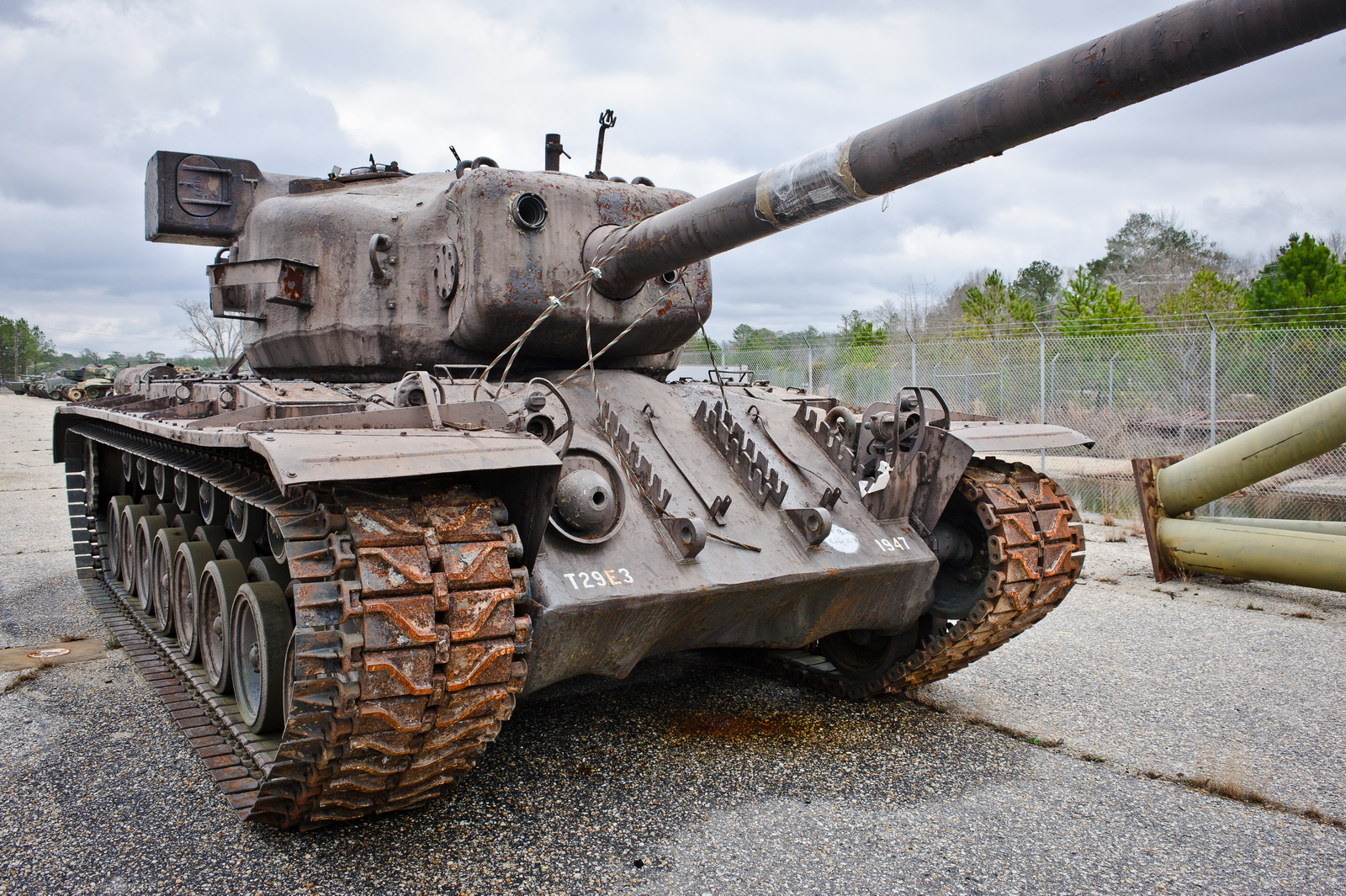
This post has some shots of the tanks the new Armor and Cavalry Museum is going to have.
http://www.theshermantank.com/sherman/58-special-gallery-2-shermans-at-fort-benning/
See this related story on the Washington Post for some info on the Museum.
https://www.washingtonpost.com/news/retropolis/wp/2017/08/03/a-battered-world-war-ii-hero-of-bastogne-gets-a-new-home-and-museum-built-around-it/?utm_term=.519e8ecfaaae
The Jumbo was often used to lead assaults for that very reason – however – it had the same fatal flaw of the German cats. It was too heavy. Suspension, wheels, drive train and transmission took heavy punishment.
It is interesting everybody nowadays is accusing others of ‘fakenews’ and ‘alternative facts’ and use insults and polarisation as weapon of choice.
You know the USA has Desinformation as one of its prime strategic weapons? Or you are not aware of this? Then see the multitude of efforts to re-validate the Sherman.
I have a challenge for you: Define a system of getting the truth on the table, using logic, facts, sources and their relative validation. The outcome can be between +1 and -1, as validation of a statement. Since logic is already existing, I propose to use formal logic like is used in science. Since facts will be disputed, and sources claimed to be biased, there need to be a mutual agreed upon validation method. If you don’t come up with one I would propose to use well known scientists as experts, where a mutual agreed upon qualification would make the acceptable for the other side. Then both sides come up with three experts, and facts and sources will be validated by simple counting. If no, or less than three expert can validate the opinion of one side, the count will be simply accepted as less than the other side.
A complete construction of a logic statement can than be evaluated according to these rules, and for instance an outcome could be “In the majority of cases the Sherman tank outgunned the German tanks” were subparts would be defined and evaluated separate to build the total constuction.
But to keep it simple: give a better proposal if you have one.
The M4 series Sherman didn’t outgun the Panzer I,II, III and the 38(t) which the Nazis built ~7500 vehicles? The M3 gun was on par with the KWK39 of the Panzer IV of which only 7000 were built. Only 5000 Panthers and 2500 Tigers and King Tigers were built. So what about the statement that the sherman were on par or outgunned German tanks don’t you understand? Over 10,000 76mm gunned Shermans were built which did outgun every German tank except the Panthers and Tigers. Maybe you should read more and understand what you read before going into a diatribe about the research that was done. The main fault of the Sherman was that it’s armor was vulnerable to that Long 50mm and higher calibers used by German Panzers and PanzerJagers but in truth the Sherman did outgun most German tanks.
If you want to look at it in terms of numbers the Sherman alone did outgun the German tanks as there were more Shermans shooting at the much less numerous German tanks. Around 40K+ Shermans vs 7500 Panthers and Tigers is at least a 4 to 1 advantage in numbers of guns.
Ok, I choose to be in a Sherman; any one of them, rather than a German or any other Axis tank. My reason- The U.S. and it’s allies won the damn thing. Proof that as part of the Allied war machine the Sherman did, at the very least, play it’s part. All the warships (and boats), war planes, and tanks, etc. even the people at home in the factories, on farms, etc., etc. worked as part of that war machine. I choose the Sherman because as an example of the end-of-the-spear that men and machines played, the Sherman played a fantastic role. I chose the Sherman for what the fighting man could do with it, and the Nation that it represents; even to this day. And I’ll bet even our Russian counterparts were glad to have (even their version.)
Armour”
I’m not sure if you noticed but this site does use supporting data and sources which it openly sites. Something you and yours seems to have a problem with.
US intelligence isnt going too work that hard too convince you a weapon they used in the 40’s was serviceable. Even if it was terrible they wouldn’t be the only nation sending tracked coffins into battle at that time. Churchill and Sherman were excellent machines that complemented eachother well; Sherman edges out Churchill as the best because without Shermans Churchill casualties would be much higher due too brainwashed kids with bazooka ripoffs alone. T34 was really good considering the condition of the factories and people but its unreliability coupled with its inaccuracy makes it much more unreliable in combat; i would also argue that the armor profile wasn’t the best as crews had less interior space and when going downhill the armor losses its slope for a t34 that leaves you with 40mm and for sherman that leaves you with 60mm
“We just could not understand that the country with the highest degree of industrialization ….would not come to Normandy with the very best tank in the world, because any Sherman up to 1200 meters you could knock out, that was no problem….and being an old tankman I really pitied the fellows who had to come against a Panzer or let alone a Tiger…
https://www.youtube.com/watch?v=bfZD2_LHi5c (05:05 – 05:52)
IF they ever did run into a big German tank! Me, I’d put my M4 in gear, duck behind a hill for cover, call for air support, and if necessary I’d run parallel to the enemy for an hour or two, stop for pie at the PX and track the mother down from behind. Besides, very, very few came in contact with a big German tank without a group of friendlies beside them.
See, I spoke with several tank men also, one was an expat from Eastern Europe. They all said the same thing- ‘as an all-’round tank the Sherman was best.’ And none of them even saw a Tiger. But they did come across a lot of screaming fans in every town they rolled through.
As a tank-man you should know, as with all things tactical, etc. you don’t go head-to-head with an opponent by attacking their strengths. You ALWAYS attack their weaknesses with YOUR STRENGTHS. Can you imagine someone invading the U.S. with all it’s residents sporting a high powered weapon, sitting camped out in the mountains or endless forests? How-about we add battalions of speedy tanks (one for every block. Then let’s add in our military…
P.S. the Soviets stuck to the same tactic as the U.S. with their T-34’s. Both they and the U.S. had the same tactic (speaking of tactics.) You put your speedster tank into gear, run at (and slightly diagonal) to the Germans notoriously slower tanks, and gun the crap out of their rear ends (when you find your way to their backsides,) having hopefully tracked them along the way. Yes some would die as their tanks were shot out from underneath them, but not all did. Some hitched it back to their base and picked out another late model ride.
Both the U.S. and Russia had one glaring strength- massive industrialization, and natural resources out the ying-yang. With properly taught tactics, many intelligent men, lots of weaponry i.e. your tank + artillery + air superiority/cover + keen infantry + Lots o’ food + a fantastic mail system(even delivering fresh pastry from home) + lots of suds on your off days + lots of money for to entertain the girls in the territory you capture + lots of bullets, cannon fire, guns. etc., etc. These are all weapons that the allies took great advantage of, and most men and tanks went into battle with.
The Sherman did so many things well, and considering all I’ve pointed out, and Eisenhower’s intelligent plans (that were accepted by all the allied leaders, the Sherman was exactly the right tank for that time. It was so fast in raking over territory that the Red Ball Express had trouble keeping up. It excelled in Europe after having it’s baptism of fire in North Africa, AND Italy. After the old school commanders in North Africa were fired for awful ‘last-war’ tactics, it cleaned up in Italy overcoming even the worst situations and the best Nazi troops.
In the Pacific, again, the M4’s speed was it’s strength. Fact was, even with the Sherman’s better technology, the first side to hit a bulls eye killed the other tank. Still, as many resource and industrial hang-ups vs. the U.S. that Nazi-fied Germany had, Japan had it much worse. Japan couldn’t keep up with the U.S. manufacturing let alone our seemingly never ending resources. Both Japan and Germany had to invade and take over other territories in order to have the resources and even man power to keep their war efforts going. None-the-less, where the Sherman could be used it was utilized well. The only planned change was the run-up to the invasion of the Japanese mainland. Thank the Lord THAT never happened!
In the End the M4 and it’s variants were replaced. The discussion still goes on today- why does the U.S. still have tanks with inferior weak spots. The reasons are myriad, but mostly, in my opinion. because our military doesn’t plan on IT (the tank) to win any wars or skirmishes. We expect men to, and now days women, and a varied amount of machines and weapons. And in, like say Vietnam, we don’t ‘win’, I hope and pray that whatever it is we don’t win is far, far, and away. But it won’t be our tank’s faults, nor the lack of trying. AND whoever beats us better not show up on my back street.
If you find yourself in a “Fair Fight” your tactics SUCK!
The Sherman Had some features the Panzertroupen would had killed for:
Both tanks had a power and a manual turret traverse, on the Panther the power traverse was never used because it didn’t work. On the Sherman the manual traverse was never used because the power one had such precision. The TCs of both tanks could rotate the turret via their own personal power traverse control. Which as stated above this only benefited the Sherman TC, in fact late model M4s came with a leaf sight welded to the top of the turret that the TC would use to acquire targets for his Gunner.
The Sherman Gunner had two sights to the Panther’s one. The primary one being a top of the turret mounted telescope with a built-in gunsight. This afforded the Sherman Gunner a better view with improved situational awareness. The Panther gunner could only view the world through his coaxial sight and had to be directed by the TC to bring the gun to bear.
All modern battle tanks have fully stabilized guns. When locked onto a target they will stay that way irregardless of the movement of the tank. The Sherman gun was stabilized in the vertical axis, the Panther gun was stabilized in none. It was against German Doctrine to shoot on the move so all of their opponents fired on the move whether their guns were stabilized or not.
Shermans came from the factory with one fitty cal and three places to mount it on the turret. Typically it was placed at the back of the turret and crewed by tank born infantry. The crew would scrounge up two more 30 cals for use by the TC and the Loader on the other two mounts. In conjunction with the coaxe and bow MGs the Sherman had a better chance of defending itself against infantry armed with AT weapons that the Panther. The MG 34 of the Panther was meant for antiaircraft defense. Its 50 round magazine of 7.9mm could be depleted in 2.2 seconds. Even if the TC did hit a Jabos it probably didn’t mean anything.
The Sherman was a communication center and could be equipped with AM, FM and Walkie talky radios.
Telegraph Wire could be run to the tank and supporting infantry could talk to the tank crew via a phone booth at the rear of the hull.
Lastly the Sherman did something no Panzer ever did, it supported its infantry.
This was against German Doctrine because doing so was too costly in tanks and they had too few.
Excellent!
Eisenhower had a good quote on the matter: “It is pure bosh to say that 75 per cent of out equipment is inferior to the German material. Speaking generally the reverse is true although, of course, if you take the present Sherman and the Panther and put them in a slugging match the latter will win. One trouble is that even many of our professionals do not understand that a compromise in tank characteristics is necessary if we are to meet our own complex requirements in this type of environment.” (From Mark T. Calhoun, General Lesley J. McNair: Unsung Architect of the US Army (Kansas: University of Kansas Press, 2015), 284.)
Jack,
Great comment, thanks for posting!
A sensible quote.
About the LST, well – for sure no,
the Germans did not make them,
but they sank plenty of ’em..
look up the ‘Slapton Sands’ debacle..
& while you’re giving praise where its due,
check out the ‘Siebel ferry’..
then ask yourself why the Germans
got most of their stuff out of Sicily,
instead of it being destroyed..
..or captured wholesale, by Patton’s army..
Because most of Patton’s army was nowhere near the Germans embarkation point? He’d gone to Palermo; it was largely Montgomery who was closing on eastern Sicily.
But the real reason the Germans got away is that nobody tried hard enough to stop them. The Straits of Messina are narrow and the Germans were able to completely dominate them with anti-aircraft guns and shore guns. The Allies didn’t make the decision to take the losses needed to stop them, or to commit enough air forces to night raids to hold up the evacuation (night raids being safer from AAA and fighter defenses). AFAIK there is some debate about how seriously the Allied command took the German evacuation, which may explain the failure to stop it as much as German defenses.
A really good and refreshing article to read. I cam across this Website doing research on a Sherman I am building.
I have never felt that the Panthers and Tigers were oh so superior to the Allied tanks, but the truth is more complicated that many would have you believe.
The Panther and Tiger were harder hitting and indeed better armoured. You can go into one all day long, but to compare the Tiger and the Sherman, who were different classes, IE: heavy and medium and different roles Breakthrough and Support is totally unfiar.
What gets lost in a lot of these confrontations on forums is the reality behind each tank, and the reality is the courage of the crews in them. There can be no doubt that our boys (Brits and Americans) had the courage of lions and the dedication to duty only the most rabid Hitler lover could dream off.
So yes, the Panther and Tiger could hit harder, and were better protected, but the Sherman would always be there and always at the forefront of any battle.
That is why in my opinion it was a damn good tank.
Mind you, didn’t see any Panthers or Tigers Celebrating Victory of the war did we?
It is always the man more than the machine.
Very true I’m sick of hearing exceuses for why that german heavies didn’t win the war.
There is no doubt the Sherman was a good tank in its class. And our Tankers did a class act job in defeating Nazi armor during the war. However my Uncle was an “Easy 8” driver in 1944-45 and stated the platoon had to split up and one section maneuver to the flank (preferably the rear) to knock out an enemy tank with the anemic 75mm round.
I’m sorry but his reality and your “cavalier” treatment of actual tank-vs-tank combat are definitely two different things!
Easy 8s had a 76mm gun and if they had a HVAP round available they could kill a Panther at a thousand yards.
https://www.youtube.com/watch?v=bNjp_4jY8pY
Good example of the Desinformation campaing on the Sherman
Are you saying that the recent history corrections in the Shermans serviceability are cia disinformation? If so thats a conspiracy theory with no basis in fact. If your saying this article is correct and german tanks failed most of the time in some form or another you’re right; “tommy cooker” “ronson” they’re all just sick jokes if you manage to penetrate armor fire will ensue especially if every type of ammunition you fire has explosive filler.
Very good articles the sherman was a great tank although somewhat inferior to the panzers in a longer range fight but in close quarters the sherman excelled comparing the two in long range is like comparing the m1 garand and the Thompson very good tank though
Ah good, instead of talking about fact we start to accuse of ‘believing the Nazi lying scum stories’ and making ‘poor choices’. So we play the character card. Nice, that is how you control history. Propaganda, that is what you do. Where does that remind me off??
Yourself???
As usual by propaganda people, you get personally attacked if they cannot deal with facts and logic. What you do sir, is exactly what the Nazi’s did to the truth.
The facts and logic are simple. The German cats were complex, essentially hand built machines. They didn’t have truly interchangable parts, their drive trains were under powered and over stressed. The Sherman on the other hand was the Ford or Chevy of the tank world. It was designed to be mass produced, it was stone reliable and easy to repair. The only problem with the Sherman was that the US Army didn’t foresee the gun/armor race on the Eastern Front that drove the rapid increase of guns and armor on the German tanks. In 1942 the Sherman was clearly superior to any German tank with the exception of the Tiger 1 and in 1942 there were a grand total of 100 Tigers built. There were 8017 Shermans built in 1942. Some of those initial production Shermans were still fighting in Italy at the end of the war, I can’t find a record of a 1942 produced Tiger lasting past 1943. If the US Army had seen the need for a heavier tank in 1943 or 1944 one could have been produced, there were several projects that were developed slowly because of lack of perceived need. The Sherman was designed for a specific doctrine, the Tigers and Panthers were designed for a different one. Neither German design could travel any appreciable distance on it’s own tracks, they had to be transported by train, the Sherman could and was driven hundreds of miles on it’s own tracks without breakdowns.
Very good post,
But as I have commented else where on this site it is the Man more than the Machine.
The Sherman despite the lack of protection that it’s armor afforded it (and that was not for a lack of steel) did rack up kill ratios against the Panther.
It had the tools necessary to get off the first round, and as many more as was necessary.
I notice there is a kind of massive bias on patriotic websites on how well the Sherman did against the Panzers. This has no relation to reality in my opinon. The Sherman is useless in the tank fights in several wargame simulations, and the stories of German tankers from WWII speak for themselves. The stories from the US side I do question now since I see the reality is being formed to fit the desired historic view that the Sherman was a great tank.
Armour,
You really should look into better sources, games have to be balanced, and make for poor understanding of how things actually work in real battles. Old board games are notorius for giving the Germans far more advantages than they really had. As for the word of Nazi tankers, and believing their stories, well, I’ll take well researched history by authors like Zaloga and Hunnicutt over Nazi propaganda and lies any day. Famous Nazi German tanker Otto Carius admitted the supposed Nazi tank aces had their records inflated by large numbers purely for propaganda purposes, and either they were the kills of the unit, or simply made up. Also web sites like Archive Awareness have proven German kill claims are often totally false!
There is statistical proof the Sherman was a better tank than the Panther and other german panzers, you can read about the reports the army did in Zaloga’s book Armored Thunderbolt.
Reality is not being formed to fit a desired look, good history backed by archival documentation is showing how wrong the old, German biased, and often written histories were. Hell, the Chieftain, over on the what forums found French reports on their post war Panther use, and how these tanks could drive more than 150 kilometers on average before needing major drivetrain overhauls! These are facts, backed by documents, that only the ignorant, or biased, and that’s biased towards the Nazis, people seem to ignore.
It seems odd to me that people find it so hard to believe the Nazis were lying scum, but that’s a fact too, and trusting their war stories and kill claims is a poor choice.
No, you assume the existence of said bias, because you refuse to consider that your assumptions are invalid/in and of themselves biased..
You are basing your view on gaming information? What a moron. Do some research in some real data instead of war game bs.
Fitting name, anyway, before you go insulting someone, you should work on your reading skills. This site is based on factual real world information on the Sherman from multiple sources, from user accounts, to the manuals on the Sherman tank to the works published about it, to Army after action reports, etc. The site also reviews games that have Sherman tanks in them. Hence the all things Sherman tank tag line. No where do I say, or imply my information and opinions on the Sherman tank come from its performance in games. That would be almost as stupid as insulting someone for something you mis understood.
Anyway, thanks for the laughs.
I obviously did not make my previous statement clear. I was answering “Meplat” by stating that many of the anti-Sherman people are basing their views on the gaming industries view of the Sherman tank. I once read a response to an article on Lafayette Pool that claimed no American tanker could have achieved the record that he did because he was in a Sherman tank. There is tremendous biase against the Sherman and its crews especially when dealing with melenials.
Indeed, sorry for the misunderstanding!
I think that the largest issue is that people want to always be right, so even if proof arises contrary to their ill-founded beliefs, they dont look at it seriously. Sort of like with some other vehicles, like the P-51 and Abrams, some believe what they were told by an old history channel documentary and thus everything else people say that goes against this is wrong.
Armour,
I think you need to stop the gaming and get some sleep instead.
If you are having difficulties getting to sleep you can keep a copy of Zatagola’s
Battle of Arrocourt by your night stand.
Oh, spoiler alert.
The Panthers lost.
Most reviews of For Want of a gun are very negative. A little digging and you find the author has some serious problems in his past. This means, at least in my opinion, taking his sensationalist book, and comparing it to any of Zaloga’s work is silly. Zaloga is an acknowledged expert in the field, and DeJohn is not.
The 75 mm gun of the M4 was chosen because it could fire AP and HE.
The closest German cannon was the 75 mm Pak 40, which was a dedicated AT gun. Those would be mounted on Stug 3s or Pz 4s, both of which the M4 could punch straight through. Now while the Pak 40s could also go through an M4, it depended on who shot first,which depended on who saw the enemy first, and by that i mean the M4 would usually win as it was COVERED in periscopes which could be quickly and easily replaced without getting out of the tank